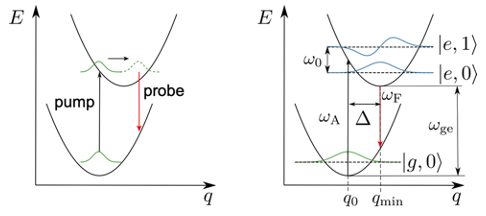Quantum information science (QIS), and in particular quantum computing, is considered an “industry of the future.” Boise State scientists are on the cutting edge of developing approaches to QIS that involve the use of molecular aggregates – with a focus on light-absorbing molecules embedded within a deoxyribonucleic acid (DNA) scaffold – that take advantage of their unique electronic properties to support quantum-based systems.
A major challenge, however, to such approaches is that all molecules also vibrate in response to temperature, and such vibrations can interfere with a molecule’s desired electronic properties.

Recently, Daniel Turner, a senior research scholar in the Nanoscale Materials and Device Group (NMDG) in the Micron School of Materials Science and Engineering, and his collaborator Paul Arpin at California State University at Chico co-authored an article published in the journal Chemical Physics.
The article provides key insights regarding how to distinguish between electronic and vibrational oscillations in a molecule. Being able to tease apart the spectral signals that identify these two types of electromagnetic oscillations, or waves, is a key step in understanding how to control their effects. Most importantly for quantum applications, a wavepacket that is coherent – in which the contributing waves are “in step” or in phase – can maintain its state over space and time. If the environment causes the contributing waves to become out of phase, the wavepacket decoheres, or dissipates, much like the waves created by dropping a rock in a pond.
Because the goal is to maintain electronic coherence across molecular aggregates, the challenge is to reduce or eliminate the decohering effects of vibrational modes in the molecule and its DNA scaffold. Broadly speaking, coherence in excitonic devices that enable energy transfer – in which an exciton is an electrically neutral quasiparticle consisting of an electron and its paired electron hole – potentially allows one to build quantum gates for quantum computation or devices that exhibit quantum entanglement (superposition of states in which the state of a pair or group of particles are dependent on the state of the others).
By simplifying the mathematical equations invoked in the theoretical description of vibrational coherence in molecules, Turner and Arpin provide an intuitive explanation of several diagnostic features frequently observed in time-dependent spectroscopy measurements using ultrafast lasers. Spectroscopy here refers to the study of the interaction between matter and electromagnetic radiation provided by a short burst of laser light. Experts have understood these diagnostic spectral signatures since the 1990s, but an intuitive explanation was lacking until now.
The work above was partially supported by a recent Department of the Navy, Office of Naval Research (ONR) grant.* This grant, along with a related Department of Energy grant, was highlighted in a recent Boise State Update article.
The new paper in Chemical Physics advances the purposes of the grant and ONR’s interest in quantum computing applications as the NMDG research team working on this grant will be studying coherence dynamics in DNA-templated molecular aggregates. This coherence can be electronic, vibrational or a mixture of the two types. The findings presented by Turner and Arpin will help the team distinguish between electronic and vibrational coherence.
By being able to study coherence dynamics, this will allow the team to delve into how long coherences in light-absorbing molecular aggregates persist or “live”: that is, potentially answer the question of how long before the system decoheres. In addition, this will provide insights into the mechanisms of decoherence and potentially provide clues to minimize their impact.
For quantum computing, the coherence time provides insight as to how long one has to make quantum computations before the system decoheres. Because coherence times are typically extremely short, cryogenic (low) temperatures often are used to reduce thermal fluctuations in the system that cause the system to rapidly decohere. In contrast, the DNA-templated system the team is studying is at room temperature, which could greatly reduce the cost and complexity of quantum computing systems.
Figure 2 from the manuscript (below) shows a conceptualization of the idea that underlies the paper. E equals energy and q is the nuclear coordinate in the figure.

* Award No. N00014−19−1−2615. Any opinions, findings and conclusions or recommendations expressed in this material are those of the authors and do not necessarily reflect the views of the Office of Naval Research.